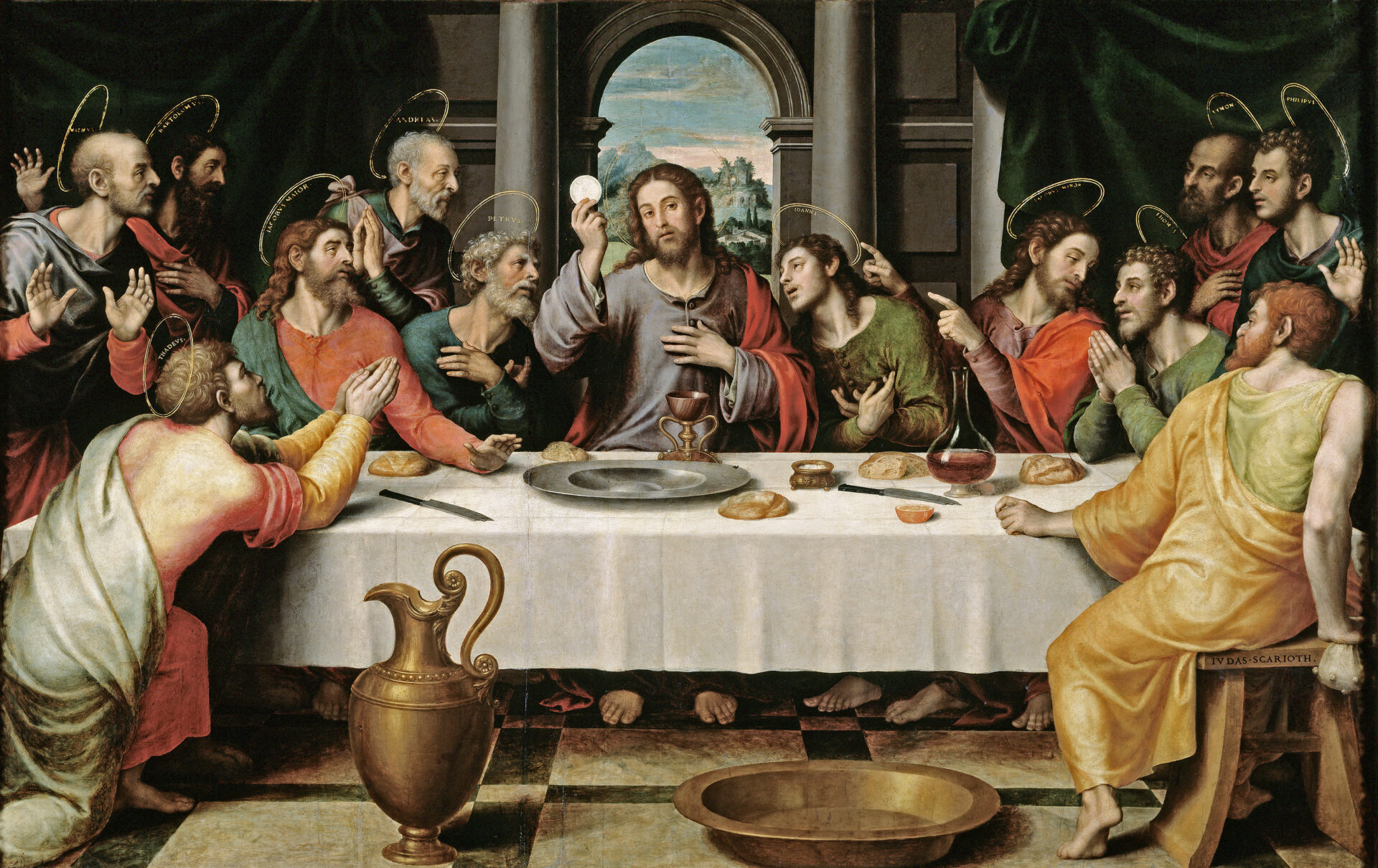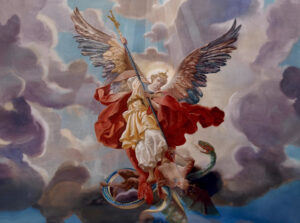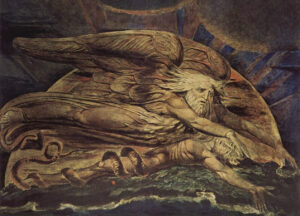Featured image: The Last Supper, oil on panel (c. 1562) by Joan de Joanes (1510–1579). Public domain.
Key Takeaways
- Historical Roots: Christian Mythology emerged from Jewish apocalyptic traditions, later blending with Greco-Roman cultural elements.
- Dynamic Adaptation: Christian narratives evolved over time to address cultural, political, and theological changes.
- Paul and Universalism: Paul’s reinterpretation of Jewish eschatology made Christian beliefs accessible to Gentile audiences.
- Augustine’s Legacy: Augustine’s theology on sin and grace became a cornerstone of Western Christian thought.
- Cultural Flexibility: Christian Mythology’s ability to integrate diverse symbols and traditions ensured its broad appeal and longevity.
- Modern Relevance: Christian myths continue to shape interfaith dialogue, global culture, and artistic expression.
Christian Mythology, encompassing the broad range of stories, symbols, and beliefs that shape Christian tradition, has long drawn scholarly attention. These narratives include accounts of Jesus’ life, death, and resurrection; Paul’s missionary journeys; and theological concepts like original sin and redemption. Rather than existing in isolation, they grew out of historical interactions among diverse communities and cultures. Understanding how these stories took form and evolved can deepen appreciation of their significance and lasting influence.
This article explores Christian Mythology through the lens of Dr. Paula Fredriksen, a prominent scholar of early Christianity. Fredriksen’s works highlight the role of historical contexts and cultural exchanges in shaping the narratives that became central to Christian identity. She emphasizes that early Christian stories were not detached theological abstractions but rather responses to the concerns of Jewish believers and, later, the Greco-Roman societies in which Christianity took root.
What follows is an examination of how Christian Mythology arose from a mix of Jewish apocalyptic expectations and Greco-Roman influences. Key themes in these narratives and their adaptation over time will be discussed, alongside the theological and mythic elements that continue to captivate modern audiences. The article also addresses scholarly debates surrounding Fredriksen’s approach and considers the contemporary relevance of these ancient stories. Readers will gain insight into how Christian Mythology developed its distinctive character and why it continues to resonate today.
Table of Contents
Historical Roots of Christian Mythology
Jewish Context
The foundations of Christian Mythology can be traced to the religious and cultural milieu of Second Temple Judaism. Early followers of Jesus were Jewish believers who understood his teachings in relation to their ancestral traditions. Ideas about the Messiah, covenant, and the Kingdom of God had circulated among Jewish groups, many of which anticipated divine intervention to deliver Israel from oppression and fulfill prophecy. Jesus’ messages about impending transformation reflected these prevailing expectations. His call for repentance and recognition of God’s sovereignty echoed well-established Jewish beliefs rather than breaking away from them.
Greco-Roman Influences
As Christian communities spread throughout the Mediterranean, they encountered the diverse cultural settings of the Greco-Roman world. Roman imperial society, with its pantheon of gods and emperor worship, brought new challenges and opportunities. Philosophical schools like Stoicism and Platonism, along with mystery cults, supplied conceptual tools that reframed how early Christians expressed their faith. Terms like “Son of God” resonated with Roman audiences and subtly challenged imperial authority by claiming that a crucified Jewish teacher held a higher status than Caesar. Such adaptations were purposeful, part of an effort to convey Jewish religious convictions to a wider audience familiar with Greek and Roman customs.
Fredriksen’s Perspective on Historical Context
Fredriksen places these developments firmly in the realm of everyday life in antiquity. She argues that Christian myths arose from practical experiences—social tensions, political upheavals, and a persistent hope for divine justice. Rather than treating doctrines as purely theoretical, she links them to the communities that nurtured them, demonstrating how beliefs about Jesus as Messiah or God’s redemptive plan surfaced in direct response to Jewish heritage and Roman rule. This perspective suggests that Christian Mythology took shape within a dynamic environment where cultural pressures and spiritual aspirations converged.
Core Themes in Christian Mythology
Jesus as an Apocalyptic Preacher
A key strand in Christian Mythology depicts Jesus as more than a moral philosopher. In his first-century setting, he proclaimed God’s imminent intervention in human affairs. He urged repentance in anticipation of a coming kingdom. Written after his death, the Gospels reframed these teachings, combining apocalyptic themes with the belief that Jesus was Israel’s promised Messiah. Narratives of his crucifixion and resurrection emerged from this conviction, presenting Jesus’ ministry as both the culmination of Israel’s story and a source of hope for all humanity.
Paul and the Gentile Mission
Paul’s role in taking Jesus’ message to non-Jewish communities is another prominent feature of Christian Mythology. In Paul: The Pagans’ Apostle, Fredriksen argues that Paul’s views of Jesus grew from Jewish scriptural foundations yet were adapted to connect with Greco-Roman audiences. Paul’s letters, with their emphasis on Christ’s crucifixion and resurrection, helped reimagine Jewish eschatological hopes as a universal promise of salvation. In Fredriksen’s view, these writings reveal an evolving mythic framework that invited people of varied backgrounds into the new faith.
Augustine and the Concept of Sin
Looking beyond the apostolic era, Fredriksen highlights Augustine’s role in weaving theology and mythic narratives together. Augustine’s reflections on sin and grace were influenced by the philosophical and doctrinal conflicts of the early fifth century. His interpretation of Adam and Eve’s story in Genesis, which described a profound moral corruption inherited by all humankind, gained lasting prominence in Western Christianity. By examining Augustine’s engagement with Manichaean, Donatist, and Pelagian controversies, Fredriksen shows how historical tensions shaped doctrines that became cornerstones of Christian Mythology.
Interplay of Jewish and Pagan Imagery
Fredriksen also notes how Christian communities combined Jewish symbols with imagery drawn from pagan traditions. Sacrifice, redemption, and spiritual renewal were reinterpreted using language that appealed to Greek-speaking audiences. Titles once attributed to emperors—“Lord” and “Savior”—were ascribed to Jesus, signifying allegiance that transcended imperial rule. This incorporation of diverse themes strengthened Christianity’s appeal in different cultural settings and exemplified the fluid character of Christian Mythology.
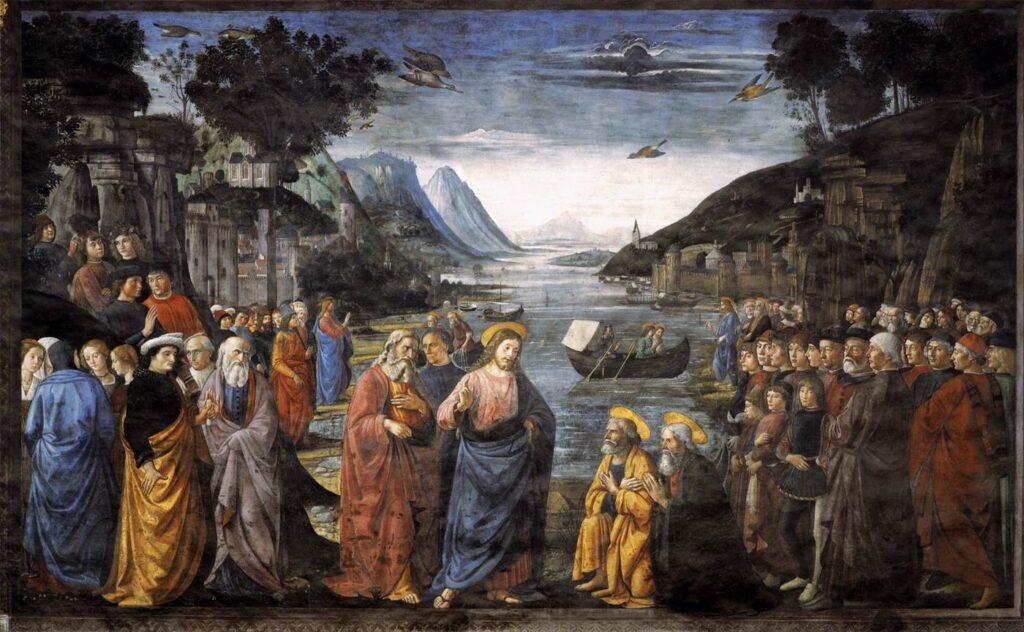
Adaptation and Evolution of Christian Stories
Processes of Transmission
In the ancient world, oral tradition was a primary means of preserving stories about Jesus’ teachings and actions before they were finally committed to writing in the Gospels. As Christianity expanded, these accounts were adapted to meet local circumstances, address theological disputes, or support evangelistic goals. The Gospels themselves, each with its distinct emphasis—such as Mark’s sense of urgency or John’s explicit recognition of Jesus’ divinity—demonstrate how early Christian narratives were anything but static. They developed as they were told and retold in different contexts.
Shifts in Cultural and Political Landscapes
Christian Mythology transformed alongside cultural and political changes in the Roman Empire. Under persecution, stories of martyrdom and the promise of heavenly reward offered hope to besieged communities. Later, under Emperor Constantine’s patronage, Christian narratives were recast to align with imperial favor, propelling the faith from the margins of Roman society to a place of official endorsement. Each transition reshaped perspectives on Jesus’ divine power and introduced fresh layers of meaning to well-known traditions.
Formation of Canonical Narratives
Over time, certain writings won recognition as canonical, solidifying mythic accounts of Jesus, the apostles, and the early church. The selection of texts, including the four Gospels and the letters of Paul, stemmed from theological consensus and practical needs for unity. Creeds followed, reflecting beliefs about Jesus’ divine sonship, his resurrection, and his eventual return. The creation of a recognized canon helped unify an array of regional interpretations, giving Christian Mythology a measure of consistency and authority within established institutional structures.
Cross-Cultural Adaptations
As Christianity extended its reach beyond the Mediterranean, believers encountered various cultural spheres, from the Middle East to Northern Europe. This prompted fresh adaptations of Christian Mythology. Local folklore and saints’ veneration often merged with existing traditions, allowing Christian figures to resonate in new settings. Such processes ensured that Christian Mythology would retain its vitality across different times and places.
Theological and Mythic Dimensions
Symbolic Significance of Core Christian Themes
Symbols and rituals lie at the heart of Christian Mythology. Baptism, for example, fuses Jewish purification practices with the broader symbolism of rebirth, while the Eucharist, rooted in Jewish Passover tradition, also draws from Greco-Roman dining customs to celebrate divine deliverance. These rites integrate mythic narratives, historical customs, and theological teachings. They provide a lens through which believers connect communal worship and liturgy to foundational stories about cosmic redemption.
Intersection of Doctrine and Story
Concepts like the Trinity, Christ’s dual nature, and humanity’s fallen condition gained traction through mythic storytelling in liturgies, hymns, and iconography. Church councils at places such as Nicaea and Chalcedon grappled with varying interpretations, ultimately articulating doctrines that both drew upon and influenced Christian narratives. Their decisions, though often couched in theological language, remained woven into the broader tapestry of Christian Mythology, shaping how believers conceptualized God’s nature and relationship to the world.
Mystical and Spiritual Aspects
Another layer of Christian Mythology emerges through mystical interpretation. From desert monasticism to medieval contemplative traditions, believers saw in biblical accounts symbolic guides for the soul’s path toward divine union. Far from undermining historical claims, these readings sought deeper spiritual truths within existing narratives. Figures like Augustine exemplify a balance between biblical literalism and allegorical depth. The result is a multifaceted mythology that addresses communal identity, doctrinal formulation, and personal spirituality.
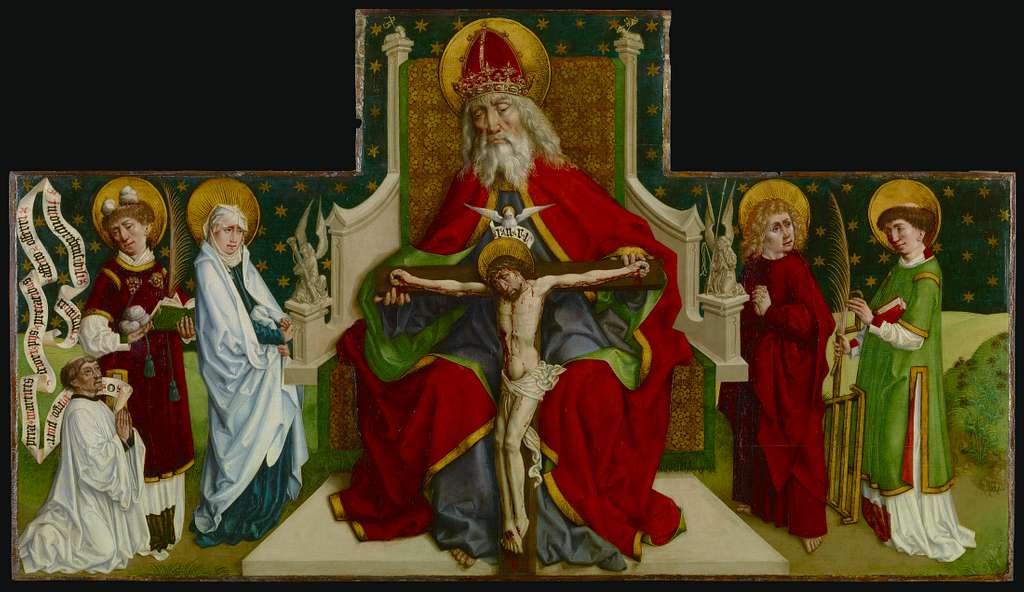
Controversies and Debates
Jewish Roots vs. Greco-Roman Innovation
Fredriksen’s analysis of Christian Mythology often stimulates debate over the degree to which Christianity’s identity remains Jewish or transforms through Greco-Roman adaptation. While some scholars view the new faith as a radical departure from Judaism, others see continuity with Jewish traditions, emphasizing that Jesus and Paul operated within a firmly Jewish setting. These discussions highlight shifting perspectives on how much Christian Mythology owes to its Jewish origins versus the innovations sparked by Roman cultural encounters.
Nature of Jesus’ Identity
Disputes also arise over how to interpret Jesus’ identity. Some scholars give precedence to the later church’s doctrinal stance, which presents Jesus as eternally divine. By contrast, Fredriksen’s view that Jesus initially functioned as a Jewish apocalyptic preacher offers a historical perspective, one that emphasizes cultural and theological evolution. This invites questions about how mythic narratives grow from a historical base and gain fresh significance across time.
Augustine’s Influence on Western Christianity
Fredriksen’s work on Augustine has prompted reevaluation of how doctrines like original sin and divine grace became integral to Western Christian thought. She sees Augustine’s ideas as products of particular historical debates, rather than universal, timeless truths. Locating Augustine among Manichaean, Donatist, and Pelagian controversies reveals how specific challenges helped shape his theological stances. This approach underscores the historical roots of teachings often regarded as overarching Christian doctrines.
Scholarly Exchanges and Future Paths
These controversies spark ongoing scholarly conversation and broaden the scope of Christian studies, reminding researchers that Christian Mythology emerges from concrete contexts. Whether or not one shares Fredriksen’s conclusions, her methods encourage deeper exploration of how religious stories intersect with lived realities.
Modern Relevance of Christian Mythology
Influence on Interfaith and Cultural Dialogue
Christian Mythology remains influential in interfaith exchanges. Scholars have shown how interwoven Jewish and Christian traditions are, fostering constructive dialogue among different faiths. Appreciating these shared roots can reduce tensions and encourage a more nuanced understanding of religious identities. Even outside formal theological circles, knowledge of these historical links offers valuable perspectives for cultural discussions and collaborative efforts.
Christian Symbols in Contemporary Culture
Christian imagery still shapes much of today’s literature, film, and art, often recast in secular contexts. Themes of sacrifice, resurrection, and moral transformation—once expressed in the language of first-century Judea and the Greco-Roman Empire—reappear in stories addressing modern social issues. This cultural adaptability, already evident in the church’s early engagement with Roman society, continues as contemporary creators invoke and reinterpret sacred motifs.
Potential Directions for Research
Fredriksen’s interdisciplinary approach—combining textual analysis, historical sociology, and archaeology—sets a solid example for future research. Advancements in digital humanities now enable more detailed study of ancient texts, opening new pathways to uncover how certain mythic motifs—like “light vs. darkness” or martyrdom—evolved as Christian communities encountered fresh challenges or philosophical questions. Such endeavors underscore that Christian Mythology, rather than a static archive, is a record of ongoing cultural and theological transformation.
In this respect, Christian Mythology endures as a testament to flexible and resonant storytelling. Its continuing impact illustrates the importance of studying how myths form, endure, and adapt to shifting social and historical realities.
Conclusion
Christian Mythology, as described by Dr. Paula Fredriksen, is an evolving tapestry of narratives, beliefs, and rituals rooted in Judaism and enriched by Greco-Roman influences. Tales centered on Jesus’ teachings, Paul’s outreach, and early theological developments did not remain unchanged; rather, they adapted to new contexts, controversies, and needs.
Fredriksen’s work places these myths in their cultural and political settings, emphasizing their human dimension. They originated as responses to communal and personal challenges, shaped by the interplay of faith, hope, and historical circumstance.
Today, these same narratives continue to reverberate in religious practice, global culture, and artistic expression. The adaptability that once carried Christianity across various regions remains evident as its symbols and stories are reimagined for contemporary audiences. Whether encountered through theological study, historical research, or popular media, Fredriksen’s insights encourage us to consider both the ancient origins and lasting legacy of Christian Mythology, reminding us that such stories bridge the distance between past and present.

